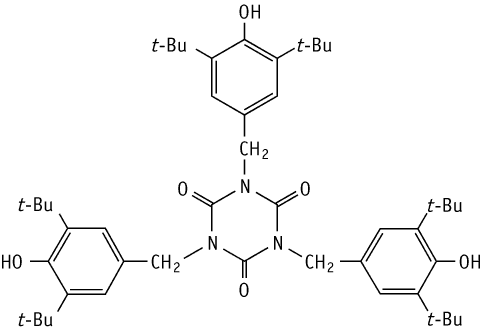

1,3,5-Tris(3,5-di-tert-butyl-4-hydroxybenzyl)isocyanuric acid was studied for oral toxicity in rats in a 28-day repeat dose toxicity test at doses of 0, 100, 300 and 1000 mg/kg.
No effects due to administration of the test substance were observed regarding clinical signs, body weights, food consumption, urinalysis, water consumption, hematological examination, blood chemical examination or pathological examination.
The NOEL is considered to be 1000 mg/kg/day for both sexes.
Genotoxicity of 1,3,5-tris(3,5-di-tert-butyl-4-hydroxybenzyl)isocyanuric acid was studied by a reverse mutation test in bacteria. This substance was not mutagenic in Salmonella typhimurium TA100, TA98, TA1535, TA1537 or Escherichia coli WP2 uvrA, with or without an exogenous metabolic activation system.
Genotoxicity of 1,3,5-tris(3,5-di-tert-butyl-4-hydroxybenzyl)isocyanuric acid was studied by chromosomal aberration test in cultured Chinese hamster lung (CHL/IU) cells.
1,3,5-Tris(3,5-di-tert-butyl-4-hydroxybenzyl)isocyanuric acid did not induce structural chromosomal aberrations under the present test conditions, but induced polyploidy in the absence of S9 mix.
| Purity | : | 100 % |
| Test species/strain | : | Rat/Crj:CD(SD)IGS |
| Test method | : | OECD Test Guideline 401 |
| Route | : | Oral (Gavage) |
| Dosage | : | 0 (Vehicle), 2000 mg/kg |
| Number of animals/group | : | Males, 5; females, 5 |
| Vehicle | : | 0.5 % Hydroxypropyl methylcellulose solution |
| GLP | : | Yes |
Test results:
| Purity | : | 100 % |
| Test species/strain | : | Rat/Crj:CD(SD)IGS |
| Test method | : | Guideline for 28-Day Repeated Dose Toxicity Test in Mammalian Species (Chemical Substances Control Law of Japan) |
| Route | : | Oral (Gavage) |
| Dosage | : | 0 (Vehicle), 100, 300, 1000 mg/kg/day |
| Number of animals/group | : | Males, 6; females, 6 |
| Vehicle | : | 0.5 % Hydroxypropyl methylcellulose solution |
| Administration period | : | Males and females, 28 days |
| Terminal killing | : | Days 29 or 43 |
| GLP | : | Yes |
Test results:
The NOEL is considered to be 1000 mg/kg/day for both sexes.
| Purity | : | 100 % |
| Test species/strains | : | Salmonella typhimurium TA100, TA1535, TA98, TA1537, Escherichia coli WP2 uvrA |
| Test method | : | Guidelines for Screening Mutagenicity Testing of Chemicals (Chemical Substances Control Law of Japan) and OECD Test Guideline 471 |
| Procedures | : | Pre-incubation method |
| Solvent | : | Dimethyl sulfoxide |
| Positive controls | : | -S9 mix; 2-(2-Furyl)-3-(5-nitro-2-furyl)acrylamide (TA100, TA98, WP2 uvrA), Sodium azide (TA1535) and 9-Amino-acridine (TA1537) +S9 mix; 2-Aminoanthracene (five strains) |
| Dosage | : | -S9 mix; 0, 313, 625, 1250, 2500, 5000 μg/plate (five strains) +S9 mix; 0, 313, 625, 1250, 2500, 5000 μg/plate (five strains) |
| S9 | : | Rat liver, induced with phenobarbital and 5,6-benzoflavon |
| Plates/test | : | 3 (1 for the cytotoxicity test) |
| Number of replicates | : | 2 (plus 1 cytotoxicity test) |
| GLP | : | Yes |
Test results:
Genetic effects:
Salmonella typhimurium TA100, TA98, TA1535, TA1537
| + | ? | - | |
| Without metabolic activation: | [ ] | [ ] | [*] |
| With metabolic activation: | [ ] | [ ] | [*] |
Escherichia coli WP2 uvrA
| + | ? | - | |
| Without metabolic activation: | [ ] | [ ] | [*] |
| With metabolic activation: | [ ] | [ ] | [*] |
| Purity | : | 100 % |
| Type of cell used | : | Chinese hamster lung (CHL/IU) cells |
| Test method | : | Guidelines for Screening Mutagenicity Testing of Chemicals (Chemical Substances Control Law of Japan) and OECD Test Guideline 473 |
| Vehicle | : | 0.5 % Sodium carboxymethylcellulose solution |
| Positive controls | : | -S9 mix; Mitomycin C +S9 mix; Cyclophosphamide |
| Dosage | : | -S9 mix (short-term treatment); 0, 1.3, 2.5, 5.0 mg/mL +S9 mix (short-term treatment); 0, 1.3, 2.5, 5.0 mg/mL -S9 mix (continuous treatment); 0, 1.3, 2.5, 5.0 mg/mL |
| S9 | : | Rat liver, induced with phenobarbital and 5,6-benzoflavone |
| Plates/test | : | 2 |
| GLP | : | Yes |
Test results:
| Lowest concentration producing cytogenetic effects in vitro | : | ||
| Without metabolic activation (short-term treatment) | : | 2.5 mg/mL (polyploidy) | |
| Without metabolic activation (continuous treatment) | : | 1.3 mg/mL (polyploidy) | |
Genotoxic effects:
| clastogenicity | polyploidy | |||||
| + | ? | - | + | ? | - | |
| Without metabolic activation: | [ ] | [ ] | [*] | [*] | [ ] | [ ] |
| With metabolic activation: | [ ] | [ ] | [*] | [ ] | [ ] | [*] |
| 1) | The tests were performed by Bozo Research Center Inc, 1284, Kamado, Gotemba-shi, Shizuoka, 412-0039, Japan. Tel +81-550-82-2000 Fax +81-550-82-2379 |
| 2) | The tests were performed by the Hatano Research Institute, Food and Drug Safety Center, 729-5 Ochiai, Hadano-shi, Kanagawa, 257-8523, Japan. Tel +81-463-82-4751 Fax +81-463-82-9627 |